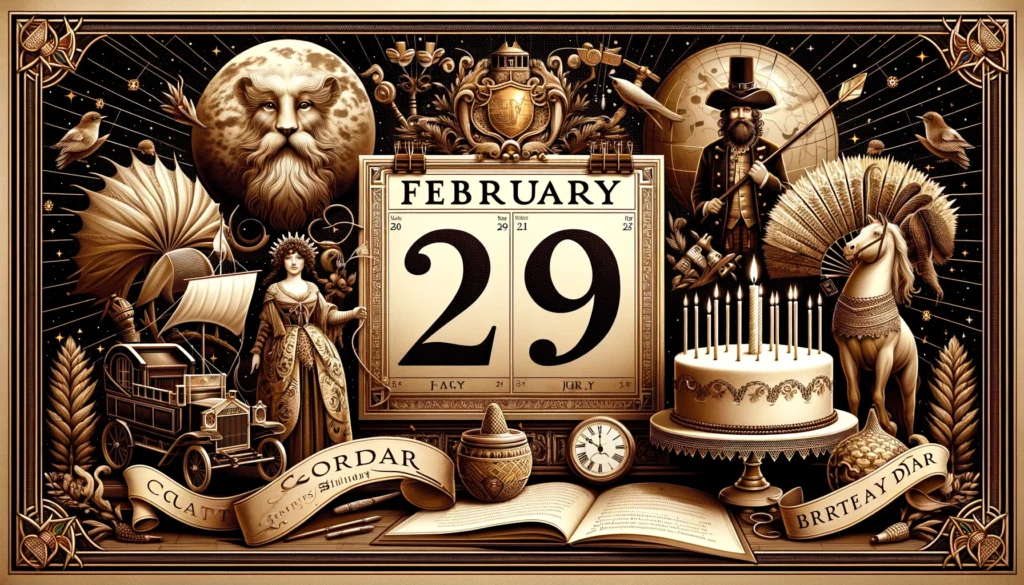
Every four years, the calendar gifts us an extra day in February, extending the month to 29 days. This phenomenon, known as a leap year, is more than just a quirk of the Gregorian calendar. It is a day shrouded in myths, imbued with traditions, and celebrated with unique customs around the world.
Our article takes you on a journey through time and across continents to explore the captivating lore and varied practices associated with leap years.
The Origins of the Leap Year
The leap year was introduced by Julius Caesar in 45 BCE in what is known as the Julian calendar. The aim was to realign the human-made calendar with the solar year – the actual time it takes for the Earth to orbit the sun. Without the addition of a leap day every four years, we would lose almost six hours off our calendar each year. Over centuries, this would significantly shift the seasons out of alignment with the calendar.
Traditions and Customs
Ireland and the Legend of St. Bridget
In the lush landscapes of Ireland, where folklore and tradition weave through the fabric of everyday life, leap year holds a special place, particularly for its unique custom concerning marriage proposals. This quaint tradition, deeply rooted in Irish culture, turns the tables on conventional roles, granting women the opportunity to propose to men on February 29th, a day that defies the ordinary and opens the door to extraordinary possibilities.
The story of this leap year custom is said to have originated from an old Irish legend involving St. Bridget and St. Patrick. As the tale goes, St. Bridget, feeling that women had to wait far too long for their suitors to propose, broached this inequity with St. Patrick. In response, he granted women the singular opportunity to take matters into their own hands and propose marriage on leap day, once every four years. This decree was seen as a way to balance traditional roles and courtship norms, albeit temporarily, giving women agency in a decisively significant aspect of their lives.
This leap day tradition is celebrated with a sense of humor and joy across Ireland, embodying the country’s love for stories and the power of flipping expectations. It’s a day when the usual social conventions are playfully suspended, and the spirit of adventure is encouraged. In towns and cities alike, leap day becomes a canvas for romantic gestures, community events, and the sharing of tales that honor both the history and the whimsy of this ancient custom.
Today, while the leap year proposal tradition might not be followed as strictly as in bygone days, it continues to inspire and capture the imagination, not just in Ireland but around the world.

The movie ‘Leap Year’ charmingly navigates the whimsical tale of a woman who journeys to Ireland to propose to her boyfriend on February 29th, adhering to an Irish tradition, only to encounter unexpected detours and a budding romance that turns her life upside down.
Scotland and the Unlucky Leap Year
In the tapestry of leap year folklore and tradition, Scotland holds a particularly unique thread. The Scottish have long harbored a cautious stance towards leap years, enveloped in a blend of superstition and reverence for the additional day that February gains every four years. Historically, leap years in Scotland were viewed with a hint of wariness, believed to upset the natural order and bring unpredictability not just to the weather but to life itself.
One of the most enduring Scottish beliefs associated with leap years is the idea that it is unlucky to undertake significant life events during this time. Marriages, in particular, were advised against, with an old Scottish adage warning that those who wed in a leap year were likely to endure a tumultuous marriage.

This superstition reflects a broader cultural caution towards the anomaly of the leap year, a period seen as being out of sync with the rhythm of the natural world.
Beyond matrimonial concerns, leap years were also thought to affect the agricultural cycle, with farmers showing reluctance to plant crops during this time for fear they would not thrive. This intertwining of leap year with elements of luck and prosperity underscores the deep-seated cultural significance these additional days hold, viewed as a time when the usual rules did not apply, and caution was warranted.
Myths and Superstitions
The Pirate of Leap Year:
Legend has it that the infamous pirate William May, better known as Captain Leap Year, would only raid ships on February 29th. It was said that his ship, The Eternal Calendar, could navigate through time, appearing only on leap days to carry out his plunders.

The Leap Year Babies
People born on February 29th, known as “leaplings” or “leapers,” are often thought to possess unique talents and luck. Various cultures view being born on this day as special, attributing to leaplings various magical properties or extraordinary fates.
Celebrations Around the World

Anthony, Texas: The Leap Year Capital:
Anthony, the self-proclaimed “Leap Year Capital of the World,” hosts a festival every four years to celebrate leap day. The event includes a guided trip to Aztec Cave, fun runs, and parties—all in honor of leap day and those born on February 29th.
Leap Day in Different Cultures
While not all countries have specific leap day traditions, many around the world acknowledge the day with humor, special events, or by simply doing something out of the ordinary to mark the rarity of the date.
The leap year is a reminder of the complexities and wonders of timekeeping. Around the world, it inspires a mix of reverence, superstition, and celebration. Whether it’s viewed as a day of special luck, a time for unusual traditions, or just an extra 24 hours to enjoy, leap year continues to fascinate and inspire stories and customs across cultures.
As we continue to celebrate and navigate these quadrennial curiosities, the leap year remains a testament to humanity’s enduring effort to synchronize our lives with the cosmos.